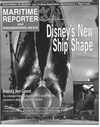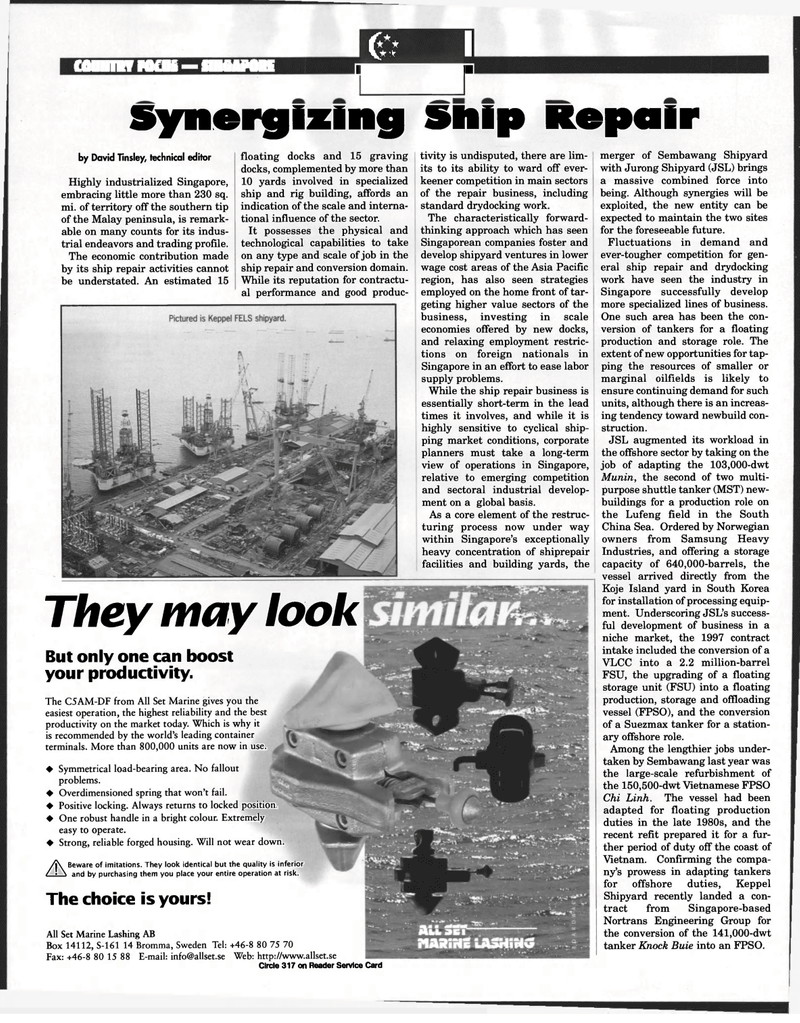
Page 86: of Maritime Reporter Magazine (March 1998)
Read this page in Pdf, Flash or Html5 edition of March 1998 Maritime Reporter Magazine
f AIIMTDV cnriic CIMftADADE e? i lUUNTKY rUvUi — JINuMrUKt i •
Synerglzing snip Repair by David Tinsley, technical editor
Highly industrialized Singapore, embracing little more than 230 sq. mi. of territory off the southern tip of the Malay peninsula, is remark- able on many counts for its indus- trial endeavors and trading profile.
The economic contribution made by its ship repair activities cannot be understated. An estimated 15 floating docks and 15 graving docks, complemented by more than 10 yards involved in specialized ship and rig building, affords an indication of the scale and interna- tional influence of the sector.
It possesses the physical and technological capabilities to take on any type and scale of job in the ship repair and conversion domain.
While its reputation for contractu- al performance and good produc-
They may look
But only one can boost your productivity.
The C5AM-DF from All Set Marine gives you the easiest operation, the highest reliability and the best productivity on the market today. Which is why it is recommended by the world's leading container terminals. More than 800,000 units are now in use. • Symmetrical load-bearing area. No fallout problems. • Overdimensioned spring that won't fail. • Positive locking. Always returns to locked position, • One robust handle in a bright colour. Extremely easy to operate. • Strong, reliable forged housing. Will not wear down.
Beware of imitations. They look identical but the quality is inferior and by purchasing them you place your entire operation at risk. A
The choice is yours!
All Set Marine Lashing AB
Box 14112, S-161 14 Bromma, Sweden Tel: +46-8 80 75 70
Fax: +46-8 80 15 88 E-mail: [email protected] Web: http://www.allset.se
Circle 317 on Reader Service Card tivity is undisputed, there are lim- its to its ability to ward off ever- keener competition in main sectors of the repair business, including standard drydocking work.
The characteristically forward- thinking approach which has seen
Singaporean companies foster and develop shipyard ventures in lower wage cost areas of the Asia Pacific region, has also seen strategies employed on the home front of tar- geting higher value sectors of the business, investing in scale economies offered by new docks, and relaxing employment restric- tions on foreign nationals in
Singapore in an effort to ease labor supply problems.
While the ship repair business is essentially short-term in the lead times it involves, and while it is highly sensitive to cyclical ship- ping market conditions, corporate planners must take a long-term view of operations in Singapore, relative to emerging competition and sectoral industrial develop- ment on a global basis.
As a core element of the restruc- turing process now under way within Singapore's exceptionally heavy concentration of shiprepair facilities and building yards, the merger of Sembawang Shipyard with Jurong Shipyard (JSL) brings a massive combined force into being. Although synergies will be exploited, the new entity can be expected to maintain the two sites for the foreseeable future.
Fluctuations in demand and ever-tougher competition for gen- eral ship repair and drydocking work have seen the industry in
Singapore successfully develop more specialized lines of business.
One such area has been the con- version of tankers for a floating production and storage role. The extent of new opportunities for tap- ping the resources of smaller or marginal oilfields is likely to ensure continuing demand for such units, although there is an increas- ing tendency toward newbuild con- struction.
JSL augmented its workload in the offshore sector by taking on the job of adapting the 103,000-dwt
Munin, the second of two multi- purpose shuttle tanker (MST) new- buildings for a production role on the Lufeng field in the South
China Sea. Ordered by Norwegian owners from Samsung Heavy
Industries, and offering a storage capacity of 640,000-barrels, the vessel arrived directly from the
Koje Island yard in South Korea for installation of processing equip- ment. Underscoring JSL's success- ful development of business in a niche market, the 1997 contract intake included the conversion of a
VLCC into a 2.2 million-barrel
FSU, the upgrading of a floating storage unit (FSU) into a floating production, storage and offloading vessel (FPSO), and the conversion of a Suezmax tanker for a station- ary offshore role.
Among the lengthier jobs under- taken by Sembawang last year was the large-scale refurbishment of the 150,500-dwt Vietnamese FPSO
Chi Link. The vessel had been adapted for floating production duties in the late 1980s, and the recent refit prepared it for a fur- ther period of duty off the coast of
Vietnam. Confirming the compa- ny's prowess in adapting tankers for offshore duties, Keppel
Shipyard recently landed a con- tract from Singapore-based
Nortrans Engineering Group for the conversion of the 141,000-dwt tanker Knock Buie into an FPSO.

 85
85

 87
87
